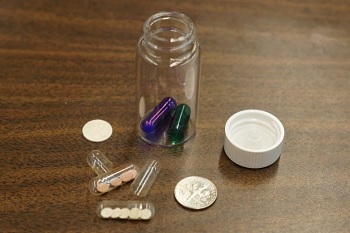 |
| Capsules filled with mucoadhesive patches--Courtesy of Sonia Fernandez |
Pills and patches are two drug delivery methods many patients would prefer to needles, especially when it comes to the number of injections a diabetic needs throughout the day. And now, researchers at UC Santa Barbara have combined the two to deliver insulin effectively across the intestinal wall into the blood, which could help overcome the difficulties in developing oral insulin.
To achieve the pill-patch combination, the scientists packed several small mucoadhesive patches--loaded with insulin--into enteric-coated capsules. The pill itself is designed to withstand the acids in the stomach and make its way into the small intestine, where it opens to release the patches. The patches then adhere to the intestinal wall and release the insulin there. Because it makes direct contact with the intestinal surface, the insulin avoids the enzymes that would normally break it down, rendering it useless as a treatment.
Oral insulin is a coveted administration technique among scientists and biotechs as it represents a treatment regimen that many diabetics would rather undergo than the ritual of needles each day. Several companies have come close to creating an effective model, but getting insulin past the gut enzymes can be troublesome. Israel-based Oramed ($ORMP) has gotten the furthest into the clinic with its Type 2 diabetes capsule, but has still seen its share of problems with formulation and inconsistent release. Novo Nordisk ($NVO), Bristol-Myers Squibb ($BMY) and Biocon are also looking into oral options.
With more than 29 million diabetics in the U.S., according to the CDC, oral insulin could be a huge windfall for any company that can come up with a solution.
"With diabetes, there's a tremendous need for oral delivery," lead author Samir Mitragotri of UCSB said in a statement. "People take insulin several times a day and delivery by needles is a big challenge. ... This is the first step in showing that these patches can deliver insulin."
- here's the UCSB release